非谓语动词用法归纳(语法)
- 格式:docx
- 大小:27.05 KB
- 文档页数:7
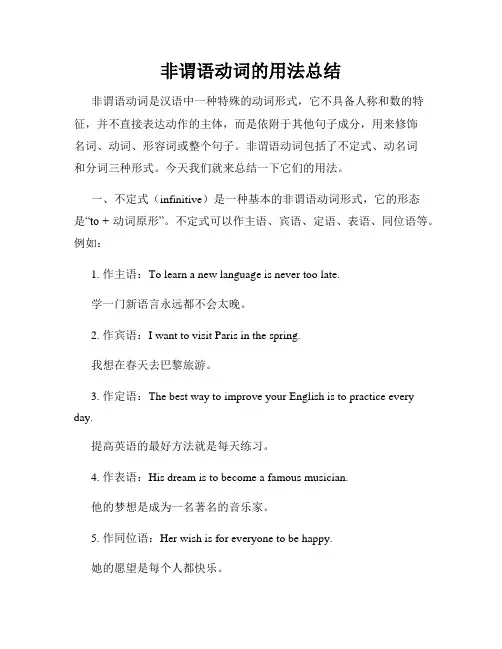
非谓语动词的用法总结非谓语动词是汉语中一种特殊的动词形式,它不具备人称和数的特征,并不直接表达动作的主体,而是依附于其他句子成分,用来修饰名词、动词、形容词或整个句子。
非谓语动词包括了不定式、动名词和分词三种形式。
今天我们就来总结一下它们的用法。
一、不定式(infinitive)是一种基本的非谓语动词形式,它的形态是“to + 动词原形”。
不定式可以作主语、宾语、定语、表语、同位语等。
例如:1. 作主语:To learn a new language is never too late.学一门新语言永远都不会太晚。
2. 作宾语:I want to visit Paris in the spring.我想在春天去巴黎旅游。
3. 作定语:The best way to improve your English is to practice every day.提高英语的最好方法就是每天练习。
4. 作表语:His dream is to become a famous musician.他的梦想是成为一名著名的音乐家。
5. 作同位语:Her wish is for everyone to be happy.她的愿望是每个人都快乐。
二、动名词(gerund)是名词化的动词,它的形态是动词的现在分词形式(V-ing),可以作主语、宾语、定语、表语等。
例如:1. 作主语:Swimming is good for your health.游泳对身体健康有好处。
2. 作宾语:He enjoys playing basketball in his free time.他喜欢在空闲时间打篮球。
3. 作定语:I have a meeting with my boss this afternoon.我今天下午有个与老板的会议。
4. 作表语:Her favorite activity is dancing.她最喜欢的活动是跳舞。

非谓语动词的用法总结动词不定式(一) 时态1. 一般式动词不定式的一般式表示与谓语动词同时或之后的行为。
如: I want to have a restI plan to attend the meeting 2. 完成式不定式的完成式表示不定式的动作发生在谓语动词所表示的动作之前的行为。
如:I ’m sorry to have kept you waiting. 3进展式不定式的动作假如同谓语动词所表示的动作同时发生那么使用不定式的进展式。
如: They seemed to be talking about something important. 4. 完成进展式不定式的完成进展式表示在谓语动词之前已经发生,并且一直进展着的动作。
如: He is said to have been working in that factory for twelve years. 〔二〕动词不定式用法:1. 作主语To master English gives us much help in the study of science 2. 作宾语I want to leave here soon. He pretended to be a doctor. 3. 作表语The most important thing is to study hard. 4. 作宾语补足语不定式作定语必须放在被修饰的名词或代词的后面。
I have no time to talk with her. 6. 作状语不定式作状语时可以表示目的、原因、结果或条件。
I came here to learn from you ( 目的) I ’m very glad to heard the news。
〔原因〕 He is old enough to go to school.(结果) To look at him ,you can’t help laughing.Notes:7. 不定式的复合构造。
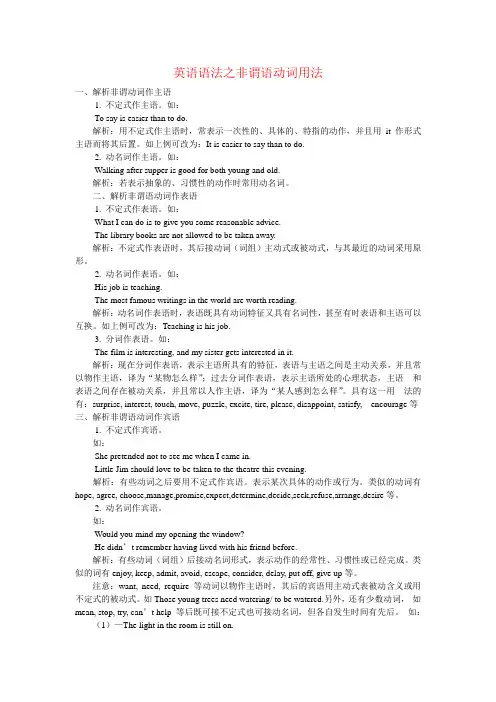
英语语法之非谓语动词用法一、解析非谓动词作主语1. 不定式作主语。
如:To say is easier than to do.解析:用不定式作主语时,常表示一次性的、具体的、特指的动作,并且用it作形式主语而将其后置。
如上例可改为:It is easier to say than to do.2. 动名词作主语。
如:Walking after supper is good for both young and old.解析:若表示抽象的、习惯性的动作时常用动名词。
二、解析非谓语动词作表语1. 不定式作表语。
如:What I can do is to give you some reasonable advice.The library books are not allowed to be taken away.解析:不定式作表语时,其后接动词(词组)主动式或被动式,与其最近的动词采用原形。
2. 动名词作表语。
如:His job is teaching.The most famous writings in the world are worth reading.解析:动名词作表语时,表语既具有动词特征又具有名词性,甚至有时表语和主语可以互换。
如上例可改为:Teaching is his job.3. 分词作表语。
如:The film is interesting, and my sister gets interested in it.解析:现在分词作表语,表示主语所具有的特征,表语与主语之间是主动关系,并且常以物作主语,译为“某物怎么样”;过去分词作表语,表示主语所处的心理状态,主语和表语之间存在被动关系,并且常以人作主语,译为“某人感到怎么样”。
具有这一用法的有:surprise, interest, touch, move, puzzle, excite, tire, please, disappoint, satisfy, encourage等三、解析非谓语动词作宾语1. 不定式作宾语。

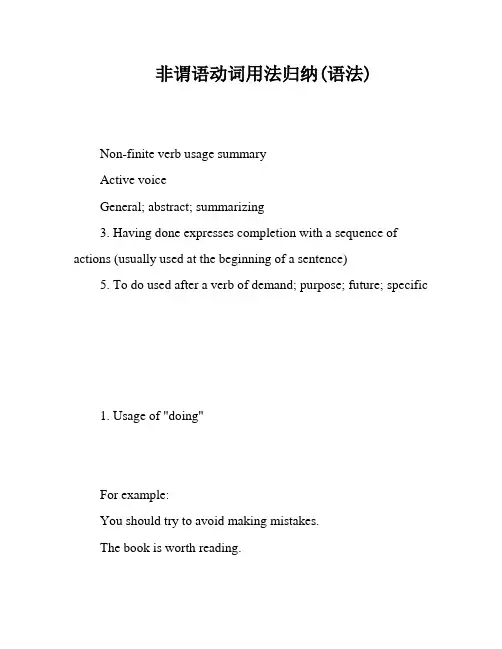
非谓语动词用法归纳(语法)Non-finite verb usage summaryActive voiceGeneral; abstract; summarizing3. Having done expresses completion with a sequence of actions (usually used at the beginning of a sentence)5. To do used after a verb of demand; purpose; future; specific1. Usage of "doing"For example:You should try to avoid making mistakes.The book is worth reading.(2) Expressing ongoing actionWalking on the grassland, I saw a snake. = When I was walking on the grassland, I saw a snake.(3) Expressing active voiceThe man speaking English is Tom = The man who speaks English is Tom.Because I was given the chance to study abroad two years ago, I still appreciate your help then.To multitask is to not fully accomplish either task. It is better to focus on one task at a time.My suggestion is to begin working immediately.When the subject is an infinitive (representing a condition) and the predicate is also an infinitive (representing a result).Seeing is believing.Working means earning a livelihood.When the subject is centered around nouns such as aim, duty, hope, idea, happiness, job, plan, problem, purpose, thing, wish, or introduced by "what" in a noun clause, the infinitive acts as a complement to supplement and explain the subject.His hope is to purchase a luxurious car in the near future.Louis Sullivan's architecture functioned to provide large, uninterrupted floor spaces and allow ample light to enter the interior.The most important thing is to negotiate with them regarding the future of the plant.The infinitive form of a verb without "to":1) Modal verbs (except for "ought," which requires "to").2) Causative verbs "let," "have," and "make," in which case "to" cannot be omitted in the passive voice.The boss made them work the whole night. = They were made to work the whole night.3) Sensory verbs such as "see," "watch," "look at," "notice," "observe," "hear," "listen to," "smell," "feel," and "find" take an object complement and omit "to." In the passive voice, "to" cannot be omitted.I saw him dance. = He was seen to dance.Note: Sensory verbs can also take a present participle to indicate a brief action in progress, while the infinitive indicates the entire process of the action.I saw him dancing. (The entire process of dancing)I witnessed him dancing gracefully. (我亲眼看到他优雅地跳舞。
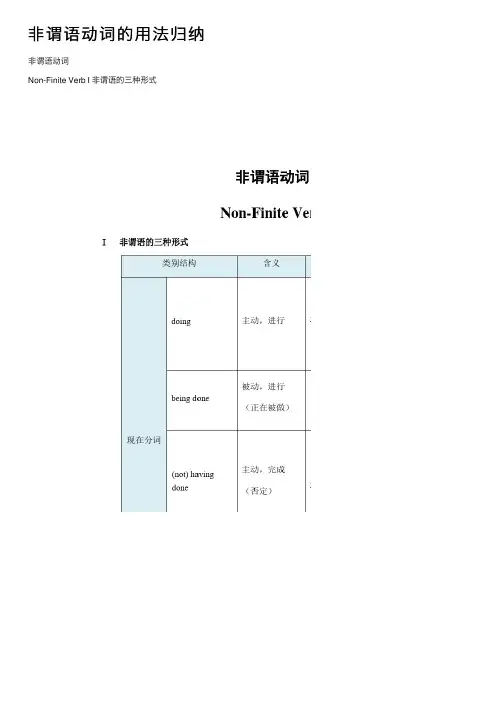
⾮谓语动词的⽤法归纳⾮谓语动词Non-Finite Verb I ⾮谓语的三种形式II 本章要点I⾮谓语语法点分述⼀、不定式to do1.不定式结构作主语To see is to believe.It is better to see something once than to hear about it a hundred times.a.在很多情况下,特别是在⼝语中,常采⽤先⾏it代替主语,⽽把不定式后置:It’s a great pleasure to be here.It is not an easy thing to master a language.★区分⽤法★1)直接⽤不定式做主语的句⼦显得更加正式。
2)如主语和表语都是to do,则只能采⽤第⼀种形式。
对敌⼈仁慈就是对⼈民残忍。
3)如是疑问句或感叹句,则只能采⽤第⼆种形式。
What is it like to be there?What a joy it was to read Barak’s book!b.⽤It is+形容词作表语时,由于逻辑主语不同导致的for和of的区别。
(1)for sb.句型中的形容词⼀般为表⽰事物的特征特点,表⽰客观形式的形容词,如:difficult, interesting, easy, impossible等。
.(2)of sb.句型中的形容词⼀般为表⽰性格、品德、⼼智能⼒,表⽰主观感情或态度的形容词,如:good, kind, nice, clever, foolish等。
★⼩试⾝⼿★1)To be fond of dancing was a certain step towards falling in love.2)对他来说,学两门外语是很困难的。
3)你能这么说很有礼貌。
★真题试炼★1)It’s important _____ the piano well.A. of him to playB. for him to playC. of him playingD. for him playing2)It’s wrong _____ her like that.A. of you to treatB. for you to treatC. of you treatingD. for you treating2.不定式结构作表语主语和表语都是不定式(其含义往往⼀是条件,⼀是结果),如:To be kind to the enemy is to be cruel to the people.To do that would be to cut the foot to fit the shoe.3.不定式结构作动词宾语(见表格附录)4.不定式结构作定语★⼩试⾝⼿★1)了解⼀个⼈最好的⽅法是和他/她⽣活⼀段时间.2)你有什么可以吃的东西吗?3)许多⽼⼈找不到可以安度晚年的地⽅.5.不定式结构作状语基本⽤法:不定式结构可以作状语,修饰动词、形容词、副词等表⽰⽬的、原因、结果、条件等。
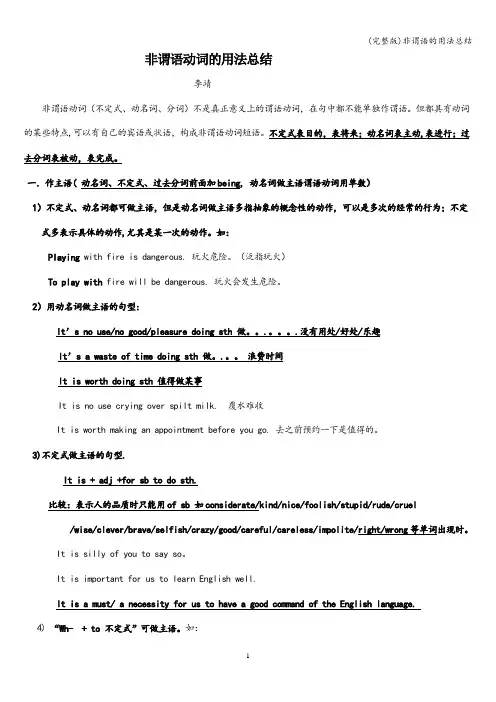
非谓语动词的用法总结李靖非谓语动词(不定式、动名词、分词)不是真正意义上的谓语动词,在句中都不能单独作谓语。
但都具有动词的某些特点,可以有自己的宾语或状语,构成非谓语动词短语。
不定式表目的,表将来;动名词表主动,表进行;过去分词表被动,表完成。
一.作主语( 动名词、不定式、过去分词前面加being, 动名词做主语谓语动词用单数)1)不定式、动名词都可做主语,但是动名词做主语多指抽象的概念性的动作,可以是多次的经常的行为;不定式多表示具体的动作,尤其是某一次的动作。
如:Playing with fire is dangerous. 玩火危险。
(泛指玩火)To play with fire will be dangerous. 玩火会发生危险。
2)用动名词做主语的句型:It’s no use/no good/pleasure doing sth 做。
.。
.没有用处/好处/乐趣It’s a waste of time doing sth 做。
.。
浪费时间It is worth doing sth 值得做某事It is no use crying over spilt milk. 覆水难收It is worth making an appointment before you go. 去之前预约一下是值得的。
3)不定式做主语的句型.It is + adj +for sb to do sth.比较:表示人的品质时只能用of sb 如considerate/kind/nice/foolish/stupid/rude/cruel /wise/clever/brave/selfish/crazy/good/careful/careless/impolite/right/wrong等单词出现时。
It is silly of you to say so。
It is important for us to learn English well.It is a must/ a necessity for us to have a good command of the English language.4) “Wh- + to 不定式”可做主语。
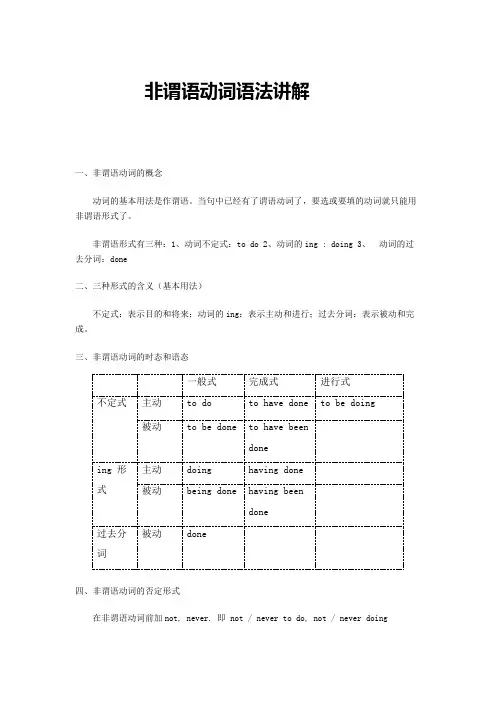
非谓语动词语法讲解一、非谓语动词的概念动词的基本用法是作谓语。
当句中已经有了谓语动词了,要选或要填的动词就只能用非谓语形式了。
非谓语形式有三种:1、动词不定式:to do 2、动词的ing : doing 3、动词的过去分词:done二、三种形式的含义(基本用法)不定式:表示目的和将来;动词的ing:表示主动和进行;过去分词:表示被动和完成。
三、非谓语动词的时态和语态一般式完成式进行式不定式主动to do to have done to be doing被动to be done to have beendoneing 形式主动doing having done 被动being done having beendone过去分词被动done四、非谓语动词的否定形式在非谓语动词前加not, never. 即 not / never to do, not / never doing五、非谓语动词的复合结构不定式的复合结构:for / of sb. to do sth.动词 ing 形式的复合结构:宾格或所有格+doing (-ing 形式作主语时,用的所有格+doing)六、非谓语动词的做题步骤1、判定是否用非谓语形式。
方法:看看句子中是否已有了谓语动词了2、找非谓语动词的逻辑主语。
方法:非谓语动词的逻辑主语一般是句子的主语。
3、判断主被动关系。
方法:非谓语动词与其逻辑主语的主动还是被动关系。
4、判断时间关系。
方法:分析句子,看看非谓语动词所表示的动作发生在谓语动作之前、之后还是同时。
之前常用 done; 之后常用to do; 同时常用doing.学习非谓语形式时,建议把三种形式一起来比较学习,会更加有效一些。
七、非谓语动词作主语和表语的比较1、不定式和动名词作主语和表语a. 不定式表示一次性的、具体的动词。
动词ing 常表示一般的、泛指的或习惯性的动作。
如:________ is a good form of exercise for both young and old.A. The walkB. WalkingC. To walkD. Walk(分析) a good form 暗示泛指一般的行为,用动名词作主语,选 Bb. 不定式作主语时,常用it 作形式主语,即用句型:It is + adj. / n. + (for / of sb. ) to do sth.It’s important for us to learn English well.It’s kind of you to help us.注意:下面几个句型是用动名词:It’s no good / use doing sth.It’s usel ess doing sth.There is no need to do sth.2、不定式、动名词、分词作表语的比较1、不定式、动名词作表语,.表示主语的内容。
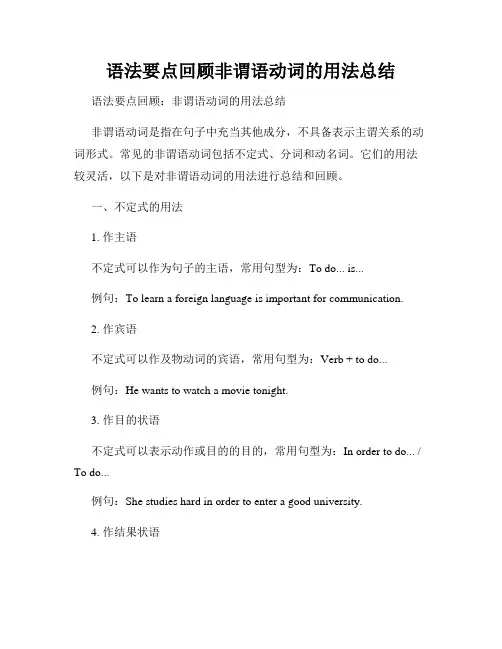
语法要点回顾非谓语动词的用法总结语法要点回顾:非谓语动词的用法总结非谓语动词是指在句子中充当其他成分,不具备表示主谓关系的动词形式。
常见的非谓语动词包括不定式、分词和动名词。
它们的用法较灵活,以下是对非谓语动词的用法进行总结和回顾。
一、不定式的用法1. 作主语不定式可以作为句子的主语,常用句型为:To do... is...例句:To learn a foreign language is important for communication.2. 作宾语不定式可以作及物动词的宾语,常用句型为:Verb + to do...例句:He wants to watch a movie tonight.3. 作目的状语不定式可以表示动作或目的的目的,常用句型为:In order to do... / To do...例句:She studies hard in order to enter a good university.4. 作结果状语不定式可以表示动作或目的的结果,常用句型为:So as to do... / In order to do...例句:He saved money so as to buy a new car.5. 作定语不定式可以修饰名词,常用句型为:Noun + to do...例句:She needs a person to help her with the project.6. 作状语不定式可以作时间、原因、方式、条件、结果等方面的状语,常用句型为:(To do...)…例句:- We woke up early to catch the train.- I came here today to see you.二、分词的用法1. 现在分词作定语现在分词可以修饰名词,常用句型为:Noun + V-ing...例句:The running water sounds very pleasant.2. 过去分词作定语过去分词可以修饰名词,常用句型为:Noun + V-ed...例句:The broken vase needs to be replaced.3. 分词短语作状语分词和分词短语可以作时间、原因、方式、条件、结果等方面的状语。
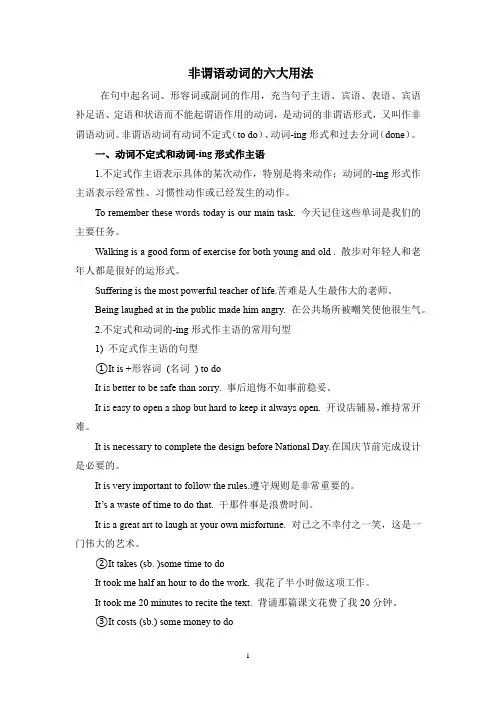
非谓语动词的六大用法在句中起名词、形容词或副词的作用,充当句子主语、宾语、表语、宾语补足语、定语和状语而不能起谓语作用的动词,是动词的非谓语形式,又叫作非谓语动词。
非谓语动词有动词不定式(to do)、动词-ing形式和过去分词(done)。
一、动词不定式和动词-ing形式作主语1.不定式作主语表示具体的某次动作,特别是将来动作;动词的-ing形式作主语表示经常性、习惯性动作或已经发生的动作。
To remember these words today is our main task. 今天记住这些单词是我们的主要任务。
Walking is a good form of exercise for both young and old . 散步对年轻人和老年人都是很好的运形式。
Suffering is the most powerful teacher of life.苦难是人生最伟大的老师。
Being laughed at in the public made him angry. 在公共场所被嘲笑使他很生气。
2.不定式和动词的-ing形式作主语的常用句型1) 不定式作主语的句型①It is +形容词(名词) to doIt is better to be safe than sorry. 事后追悔不如事前稳妥。
It is easy to open a shop but hard to keep it always open. 开设店铺易,维持常开难。
It is necessary to complete the design before National Day.在国庆节前完成设计是必要的。
It is very important to follow the rules.遵守规则是非常重要的。
It’s a waste of time to do that. 干那件事是浪费时间。
It is a great art to laugh at your own misfortune. 对己之不幸付之一笑,这是一门伟大的艺术。
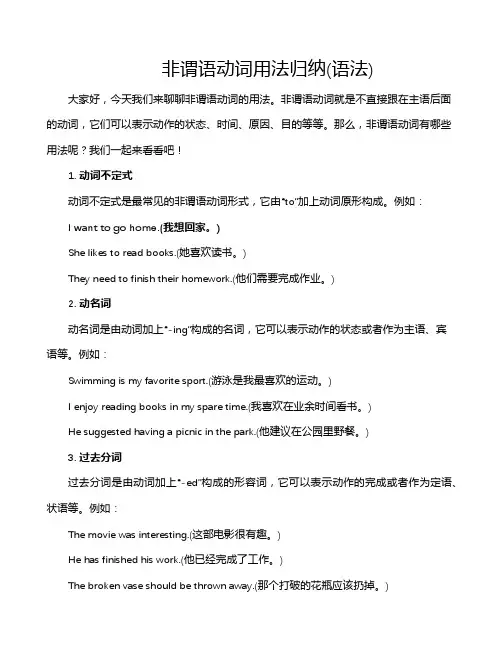
非谓语动词用法归纳(语法)大家好,今天我们来聊聊非谓语动词的用法。
非谓语动词就是不直接跟在主语后面的动词,它们可以表示动作的状态、时间、原因、目的等等。
那么,非谓语动词有哪些用法呢?我们一起来看看吧!1. 动词不定式动词不定式是最常见的非谓语动词形式,它由“to”加上动词原形构成。
例如:I want to go home.(我想回家。
)She likes to read books.(她喜欢读书。
)They need to finish their homework.(他们需要完成作业。
)2. 动名词动名词是由动词加上“-ing”构成的名词,它可以表示动作的状态或者作为主语、宾语等。
例如:Swimming is my favorite sport.(游泳是我最喜欢的运动。
)I enjoy reading books in my spare time.(我喜欢在业余时间看书。
)He suggested having a picnic in the park.(他建议在公园里野餐。
)3. 过去分词过去分词是由动词加上“-ed”构成的形容词,它可以表示动作的完成或者作为定语、状语等。
例如:The movie was interesting.(这部电影很有趣。
)He has finished his work.(他已经完成了工作。
)The broken vase should be thrown away.(那个打破的花瓶应该扔掉。
)4. 现在分词现在分词是由动词加上“-ing”构成的形容词,它可以表示动作正在进行或者作为定语、状语等。
例如:Walking in the park is good for your health.(在公园里散步对身体有好处。
)She is studying English at the moment.(她现在正在学英语。
)The running water sounds very soothing.(流水声听起来很舒缓。
非谓语动词的用法总结非谓语动词是指不具备人称、数和时态等语法特征的动词形式,主要包括动词不定式(to do)、动名词(doing)和分词(done)。
在英语语法中,非谓语动词常常用于多种不同的结构中,具有独特的功能和用法。
本文将对非谓语动词的用法进行总结,并提供相关例句来加深理解。
一、动词不定式动词不定式是非谓语动词的一种形式,一般由to + 动词原形构成。
动词不定式可以作为名词、形容词或副词的补语,也可以在句子中作主语、宾语、表语和宾补等。
以下是动词不定式的几种主要用法:1. 作主语To swim is my favorite activity.2. 作宾语She wants to eat dinner at home.3. 作表语Her dream is to become a doctor.4. 作定语I have a book to read this weekend.5. 作状语He went to the park to play basketball.6. 作宾补We need you to clean the room.二、动名词动名词是非谓语动词的一种形式,一般由动词的现在分词形式(-ing)构成。
动名词可以作为名词的主语、宾语、定语、表语和宾补等。
以下是动名词的几种主要用法:1. 作主语Swimming is good exercise.2. 作宾语I enjoy reading books.3. 作定语We had a thrilling roller coaster ride.4. 作表语His favorite activity is dancing.5. 作宾补She kept the secret by not telling anyone.三、分词分词是非谓语动词的一种形式,一般由动词的过去分词形式(-ed 或不规则形式)或现在分词形式(-ing)构成。
分词可以作为形容词的定语,修饰名词或代词。
1.doing 的用法(1)在要求动词后(作宾语):avoid避免appreciate 感激/欣赏acknowledge承认/自认admit 承认advocate提倡/主consider 考虑can't help不禁can't stand受不了contemplate细想complete完成confess坦白dislike不喜欢,讨厌deserve值得delay延迟deny否认dread可怕defer拖延detest嫌恶enjoy享有/喜爱envy嫉妒endure忍受excuse借口escape逃跑/逃避finish完成forgive原谅fancy幻想/爱好favor 造成/偏爱figure描绘/计算hate讨厌imagine设想involve卷入/包含keep保持miss错过mention说到/讲到mind 介意pardon原谅/饶恕permit允许postpone推迟practice 实行/实践prevent 阻止quit放弃停止risk冒险recall回想resist抵抗/阻止resume恢复repent悔悟resent怨恨stand坚持/忍受suggest建议save营救/储蓄tolerate忍受worth值得You should try to avoid making mistakes.The book is worth reading.The book deserves reading.(2)表进行Walking on the grassland, I saw a snake.=When I was walking on the grassland, I saw a snake. The man speaking English is Tom. = The man who is speaking English is Tom.(3)表主动The man speaking English is Tom = The man who speaks English is Tom.= The man who spoke English is Tom.Nobody dinks boiling water but boiled water.= Nobody dinks water that is boiling but the water that has boiled.(4)表伴随I stand outside waiting for Mr. Chen.I lie in bed reading a novel.(5)表性质;特点The film is very moving.She is understanding, so you had better discuss your business with her.(6)概括性,一般性Climbing mountain is very interesting.Driving a car during the rush hour is tiring.在高峰时刻开车令人厌烦。
非谓语动词语法详解.一.主语.1. 动名词和不定式作主语时,都可以用it 作形式主语,构成句型:it +be +表语+to do /doing sth. 当用作表语的是important , essential, necessary , unnecessary, possible, impossible, easy , difficult 等表示客观情况的形容词时,常用不定式作主语;当用作表语的是no use, no good, useful, useless, worth, worth while, a waste of time 等表主观短语时,常用动名词作主语。
Eg: it is important for us students to learn english well.It is impossible for them to finish the work within two hours.It is no use arguing with him about the matter.I don’t think it’s much good writing to him.It’s a waste of time trying to persuade her to agree.2.动名词短语作主语时表示抽象动作,通常不与特定的动作执行者联系在一起;不定式作主语表示具体动作,往往与特定的动作执行者联系在一起。
Eg: lying is wrong. (泛指)To lies is wrong. (特指)It’s no use crying over split milk.He realized that it was no use to go on like this.二.. 非谓语作宾语1.1)Would you mind lending me your English dictionary for a while?2) She can’t help crying after she listened to the sad story .3) I suggested trying it in a different way .4) I ‘ve been looking forward to hearing from you for a long time.5) He insisted on finishing the work before going home.6) Upon returning from Beijing, he went to visit his friends.7) He took a great delight in helping others.8) he didn’t metion having met me .9) I still remember having ever worked with him .10) I enjoyed watching TV program in the evening.11) the car needs reparing .12) the problem deserves explaining .13) This phonomenon requires studying carefully.14) The book is worth reading We don’t allow smoking in the classroom.He dislikes seeing her again.Mary is considering going abroad.Have you finished checking these machines?Working conditions keep improving, and production keeps going up , as well. He really appreciates having time to relax.He is fond of learning English.She left without telling me.1) I need to fetch a tape from a friend2) do you want me to find one stamp for you ?3) I have arranged to meet here at 10:00.I’d prefer to walk there this morning.I’d hate to leave you like that .She’d like to chat with university students.扩:1) agree , afford , aim , apply , arrange, ask , choose, claim, decide, demand, determine, fail , hope , learn , offer, plan , pretend, promise, refuse, want 等后只用to do .2)admit , allow , appreciate , avoid , consider, deny , dislike, encourage,enjoy, escape , excuse, finish , forbid , imagine, keep , mind , permit , practice 等词后只用doing3)stop doing sth / to do sth 停止做某事/停下来去做某事remember doing sth/ to do sth. 记得做过某事/记住要去做某事forget doing sth/ to do sth 记了做过某事/ 忘了做某事regret doing sth / to do sth 后悔做过某事/ 遗憾地。
非谓语动词用法总结非谓语动词是指在句子中不作谓语动词使用的动词形式,包括不定式、动名词和分词。
以下是它们的用法总结:1. 不定式(Infinitive):-结构:to + 动词原形-用法:-作主语:To learn a new language is challenging.-作宾语:She wants to eat lunch.-作宾语补足语:I find it difficult to understand.-作定语:The best way to learn is by doing.-作状语:She studies hard to succeed.2. 动名词(Gerund):-结构:动词的-ing形式-用法:-作主语:Swimming is my favorite sport.-作宾语:I enjoy reading books.-作宾语补足语:I consider him as my friend.-作定语:I saw a girl reading a book.-作状语:He left without saying goodbye.3. 分词(Participle):-有现在分词和过去分词两种形式。
-现在分词一般以-ing结尾,过去分词常以-ed、-en、-d、-t等结尾。
-用法:-作定语:The girl standing there is my sister. (现在分词)-作状语:Feeling tired, she decided to take a nap. (现在分词)-作宾语补足语:I saw the movie directed by Steven Spielberg. (过去分词)-与连系动词一起构成系表结构:The cake smells delicious. (现在分词)总的来说,非谓语动词在句子中可以充当多种不同的语法角色,包括主语、宾语、宾语补足语、定语和状语。
非谓语动词的用法总结一、非谓语动词概述非谓语动词是指不具备谓语性质的动词形式,它以独立于主谓结构的方式出现在句子中。
在英语中,非谓语动词包括不定式、现在分词和过去分词。
本文将总结非谓语动词的用法,并重点讨论其作为状语、定语和补足语的功能。
二、不定式的用法1. 作为目的状语:不定式常用来表示动作或状态的目的。
例如:“I went to the store to buy some groceries.”(我去商店买些杂货)2. 作为结果状语:不定式有时表示某个动作或状态发生的结果。
例如:“He worked hard to climb the mountain.”(他努力工作才成功登上山顶)3. 作为原因状语:不定式可以用来表示某个行为或状态发生的原因。
例如:“She stayed up late to finish her homework.”(她熬夜完成家庭作业)4. 作为条件状语:在条件句中,常使用"if"引导一个带有不定式的从句。
例如:“If you want to succeed, you must work hard.”(如果你想成功,就必须努力工作)5. 作为名词性质:不定式可以充当名词的角色,用来作主语、宾语、表语等。
例如:“To travel is my dream.”(旅行是我的梦想)6. 作为定语:不定式可以修饰名词或代词,起到定语的作用。
例如:“Thebook to read is on the shelf.”(要读的那本书在书架上)三、现在分词的用法1. 作为形容词:现在分词可用于描述一个正在进行或具有某种性质的人或事物。
例如:“She saw a crying baby in the park.”(她看到了公园里哭泣的婴儿)2. 作为状语:现在分词可以表示时间,原因,条件等意义。
例如:“Walking by the river, he felt relaxed.”(边走边看河流,他觉得很放松)3. 和系动词连用:现在分词可以和系动词连用,构成谓语部分。
非谓语动词用法归纳(语法)一、非谓语动词的定义与分类在我们的日常生活和工作中,非谓语动词无处不在。
它们是指在句子中不作主语、宾语、表语或补足语等成分,但却对句子的意义起着重要作用的动词形式。
非谓语动词分为动词不定式、动名词和过去分词三种形式。
下面我们分别来了解一下这三种非谓语动词的特点和用法。
1.1 动词不定式动词不定式是非谓语动词中最常用的一种形式,它由“to+动词原形”构成,例如:to eat、to play、to study等。
动词不定式可以作主语、宾语、表语、定语和状语等成分。
下面我们通过一些例子来具体了解一下动词不定式的用法。
例1:我喜欢吃苹果。
在这个句子中,“吃苹果”是一个动作,而“喜欢”是对这个动作的态度,所以“吃苹果”用动词不定式“to eat apples”表示。
例2:我明天要去上学。
在这个句子中,“去上学”是一个动作,而“明天”表示时间,所以“去上学”用动词不定式“to go to school”表示。
1.2 动名词动名词是动词的一种非谓语形式,它由动词原形加上-ing构成,例如:eating、playing、studying等。
动名词可以作主语、宾语、表语、定语和状语等成分。
下面我们通过一些例子来具体了解一下动名词的用法。
例3:我喜欢吃水果。
在这个句子中,“吃水果”是一个动作,而“喜欢”是对这个动作的态度,所以“吃水果”用动名词“eating fruits”表示。
例4:她正在学习汉语。
在这个句子中,“学习汉语”是一个动作,而“正在”表示进行时态,所以“学习汉语”用动名词“studying Chinese”表示。
1.3 过去分词过去分词是动词的一种非谓语形式,它由动词原形加上-ed构成,例如:eaten、played、studied等。
过去分词可以作定语、表语和状语等成分。
下面我们通过一些例子来具体了解一下过去分词的用法。
例5:我喜欢吃的水果有苹果、香蕉和橙子。
在这个句子中,“吃的水果”是一个名词短语,而“喜欢的”表示这个名词短语的特征,所以“吃的水果”用过去分词形式的名词“eating fruits”表示。
1. doi ng 的用法(1)在要求动词后 (作宾语):avoid 避免appreciate 感激/欣赏acknowledge 承认/自认admit承认advocate 提倡/ 主张con sider 考虑can't help 不禁can't sta nd 受不了con template 纟田想complete 完成confess坦白dislike不喜欢,讨厌deserve值得delay延迟deny否认dread可怕defer拖延detest嫌恶enjoy享有/喜爱envy嫉妒endure忍受excuse借口escape逃跑/逃避finish完成forgive原谅fancy幻想/爱好favor 造成/偏爱figure扌苗绘/计算hate 讨厌imagine 设想involve 卷入/包含keep 保持miss令错过mention 说到/讲到mi nd 介意pardon 原谅/饶恕permit允许postpo ne 推迟practice 实行/实践preve nt阻止quit放弃停止risk冒险recall回想resist抵抗/阻止resume恢复repent悔悟resent怨恨stand坚持/忍受suggest建议save营救/储蓄tolerate 忍受worth值得You should try to avoid making mistakes.The book is worth readi ng.The book deserves readi ng.(2)表进行Walk ing on the grassla nd, I saw a sn ake.=Whe n I was walk ing on the grassla nd, I saw a sn ake.The man speak ing En glish is T om. = The man who is speak ing En glish is Tom.(3)表主动The man speak ing En glish is T om = The man who speaks En glish is T om.=The man who spoke En glish is T om.Nobody dinks boil ing water but boiled water.= Nobody dinks water that is boil ing but the water that has boiled.(4)表伴随I sta nd outside wait ing for Mr. Chen.I lie in bed readi ng a no vel.(5)表性质;特点The film is very movi ng.She is un dersta nding, so you had better discuss your bus in ess with her.(6)概括性,一般性Climb ing mountain is very in terest ing.Driving a car during the rush hour is tiring .在高峰时刻开车令人厌烦。
(概括性,一般性)Our work is servi ng the people .(7)动名词的逻辑主语为;①人称代词的所有格+动名词;②名词'S+动名词。
例如:Tom insisted on my going with them . 他坚持要我和他们一起去。
专业word可编辑He dislikes his wife's working late .他不喜欢他妻子工作得很晚。
2. bei ng done 表示正在进行的被动The boy being criticized by Mr. Chen is Tom. = The boy who is being criticized by Mr. Chen is T om.Being criticized by Mr. Chen, the boy felt sad. = When the boy was being criticized by Mr. Chen, he felt sad.The buildi ng being built will be the tallest one in this city.=The buildi ng that is being built will be the tallest one in this city.3. having done 有先后动作表完成(一般用在句首)Having finished the class, I went home. = After I had finished the class, I went home.Having done the work, I had a short rest. = After I had done the work, I had a short rest.Having done the work, I went back home.Having been done, the work was checked by the leaders.4. having been done 用于句首;有先后动作表完成有先后动作表完成,(有过去时间或过去动作)I appreciate having been given the opportunity to study abroad two years ago.(要求动词后)=I appreciate that I was give n the opport unity to study abroad two years ago.Having bee n give n the opport unity to study abroad two years ago, I still appreciate your help the n.=Because I was give n the opport unity to study abroad two years ago, I still appreciate your help the nI appreciate having bee n give n the opport un ity to study abroad two years ago. ________I enjoy giving the opport unity to study abroad to Mr. Wang.I appreciate being given the opport unity to study abroad now.Having been finished, the report was turned in.= After the report had been finished, it was turned in.5. to do 的用法:(1)用在要求动词后:接to do的动词(作宾语)attempt 企图afford负担得起arrange 安排appear似乎,显得ask问agree同意believe 认为、相信begin 开始beg 请求bother 扰乱/烦恼care关心,喜欢choose 选择claim 要求consent 同意,赞同contrive 设法,图谋dema nd 要求desti ne 注定determ ine 决定dread 害怕desire 愿望decide 决定en able 能够expect期望endeavor努力fail不能hate憎恨/厌恶happen 碰巧hesitate 犹豫hope希望intend 想要in cli ne 有••倾向long 渴望love 爱lear n 学习mea n 意欲,打算man age 设法n eglect 忽视n eed 需要omit 忽略,漏offer提供pretend 假装plan计划prefer喜欢/宁愿prepare 准备profess表明promise 承诺/允许propose 提议refuse拒绝swear宣誓start开始seek找/寻觅try试图undertake 承接volunteer 志愿vow 起wish希望want想要(2)表示具体动作,特别是表示将来的动作(做表语)。
Our work is to serve the people .The pers on to do the job is T om. = The pers on who will do the job is T om.To do two things at a time is to do neither ______ .一次做两件事等于未做。
What I would suggest is to start work at o nee. 我的建议是立刻开始干。
. 专业word可编辑如果主语是不定式(表示条件),表语也是不定式(表示结果)。
To see is to believe. 百闻不如一见。
To work means to earn a living . 工作就是为了生活。
女口果主语是以aim,duty,hope,idea,happ in ess ,job,pla n , problem ,purpose ,thing ,wish 等为中心的名词,或以what引导的名词性从句,不定式作表语是对主语起补充说明作用。
His wish is to buy a luxurious car in the near future .他的希望是在不远的将来买一辆豪华轿车。
The fun ctio n of Louis Sulliva n's architecture was to provide large unin terrupted floor areas and to allow ample light into the interior.The most importa nt thing is to n egotiate with them about the future of the pla nt省to的动词不定式1)情态动词(除ought 外,ought to):2)使役动词let, have, make ;在被动语态中则to不能省掉。
The boss made them work the whole night. = They were made to work the whole night.3)感官动词see, watch, look at, notice , observe, hear, listen to, smell, feel, find 等后作宾补,省略to。